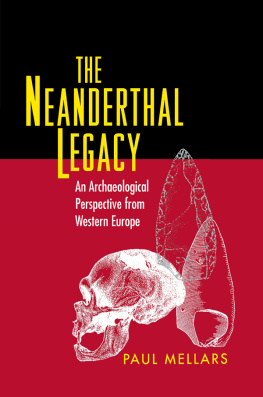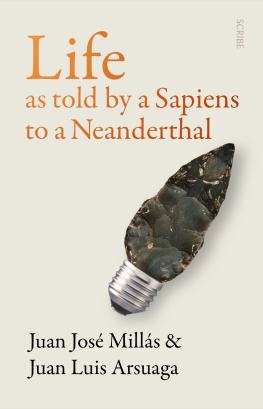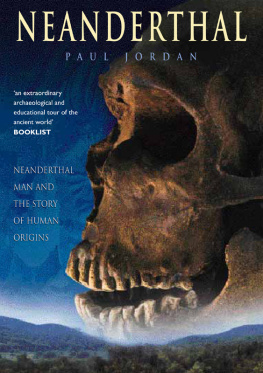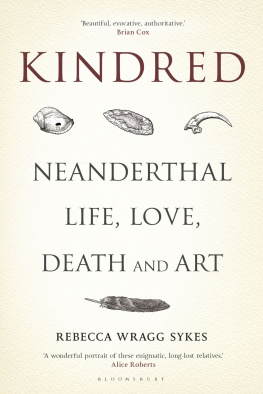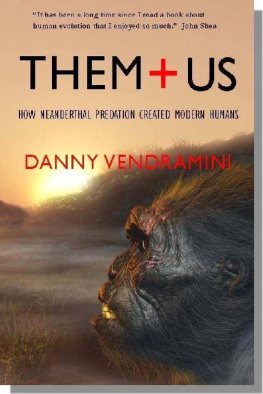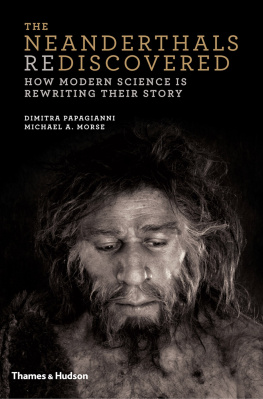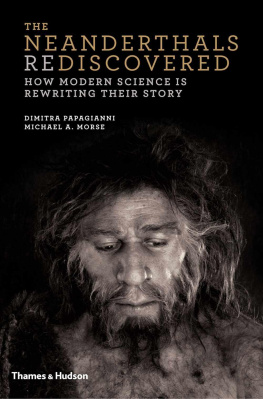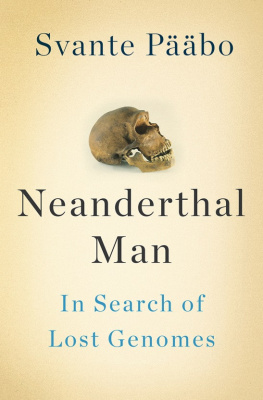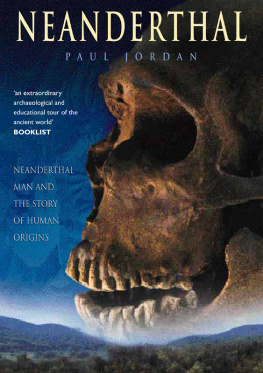
THE
NEANDERTHAL
LEGACY
An Archaeological Perspective from Western Europe
THE
NEANDERTHAL
LEGACY
An Archaeological Perspective from Western Europe
Paul Mellars
Department of Archaeology
Cambridge University, UK
PRINCETON UNIVERSITY PRESS, PRINCETON, NEW JERSEY
Copyright 1996 by Princeton University Press
Published by Princeton University Press, 41 William Street, Princeton, New Jersey 08540
In the United Kingdom: Princeton University Press, Chichester, West Sussex
All Rights Reserved
Library of Congress Cataloging-in-Publication Data
Mellars, Paul.
The Neanderthal legacy : an archaeological perspective from western Europe / Paul Mellars.
p. cm.
Includes bibliographical references and index.
ISBN 978-0-691-16798-5 (cloth : acid-free paper)
1. Neanderthals Europe. 2. Paleolithic period Europe. 3. Human evolution Europe Philosophy. 4. Behavior evolution Europe. 5. Europe Antiquities. I. Title.
GN285.M45 1995
936 dc20
95-4300
This book has been composed in Palatino
Princeton University Press books are printed on acid-free paper and meet the guidelines for permanence and durability of the Committee on Production Guidelines for Book Longevity of the Council on Library Resources
10 9 8 7 6 5 4 3 2 1
Contents
List of Tables
List of Illustrations
Preface
My colleague Chris Stringer warned me that writing a book about Neanderthals would be rather like ordering menus for College High Table dinners there would be no way of pleasing everyone. For the past eighty years or so we seem to have been caught between two opposing camps between those who see the Neanderthals as our immediate ancestors, only mildly different in at least their basic biological and behavioural patterns from fully modern populations; and those who prefer to adhere to Marcellin Boules original vision of the Neanderthals as representing an extinct side line of human evolution, with both behavioural patterns and most probably innate capacities for behaviour which were radically different from those of later populations. The recent controversies surrounding the origins and dispersal of anatomically modern populations have put the spotlight firmly onto the Neanderthals as arguably the last surviving representatives of the original archaic lineages which populated the world prior to the dramatic demographic and behavioural dispersal of genetically modern populations.
While there have been many studies of the biological and anatomical aspects of Neanderthals, there have been surprisingly few systematic attempts to review their behavioural patterns. There has of course been no shortage of excavations of Middle Palaeolithic sites, combined with a deluge of analyses of the associated stone-tool industries and (to a lesser extent) faunal assemblages. My central belief in embarking on this book was that it was only by taking a very broad-ranging look at all aspects of the behaviour and organization of Neanderthal communities their technology, subsistence patterns, spatial and demographic organization and patterns of communication and cognition that we could hope to form any overall impression of their true behavioural capacities and, in particular, how far these may have differed from those of the ensuing anatomically modern populations. As far as I am aware, this is the first book which has attempted to bring all these issues together in a single study, focussed on a specific and exceptionally rich and well documented body of archaeological evidence.
The extent to which this book depends on the research of my French colleagues will be immediately apparent from dipping into any of the individual chapters. Following the pioneering research of Franois Bordes, Andr Leroi-Gourhan and others shortly after the Second World War, there has been an extraordinary upsurge in studies of the Middle Palaeolithic over the past twenty years, extending far beyond the traditional obsession with typological and taxonomic issues which dominated the field for so long. In southwestern France the work pioneered by Jean-Philippe Rigaud on the spatial distribution and organization of Mousterian sites has been systematically extended by a number of younger colleagues most notably by Jean-Michel Geneste, Allain Turq and Christine Duchadeau-Kervazo in the Perigord region, and further south by Jacques Jaubert, Jean-Marie Le Tensorer, Liliane Meignen and others. Over the same period the research of Franoise Delpech, Jean-Luc Guadelli, Guy Laquay, Stephane Madelaine, Philip Chase and others has taken the analysis of Middle Palaeolithic faunal assemblages far beyond the traditional concern with the purely climatic and chronological aspects of the faunas, into a determined attempt to reconstruct the economic and carcase-processing strategies which lay behind the archaelogical bone assemblages. Above all, perhaps, the study of lithic technology has been revolutionized by the application of the chane opratoire approach to technological analysis (involving the use of extensive refitting studies, experimental replication techniques and microscopic use-wear analyses), as well as by systematic studies of the sources and distribution patterns of the raw materials employed for tool production.
What is remarkable about this recent work is not merely its scientific quality, but the extent to which much of the critical data and analysis still remains embedded in a range of specialist site reports, conference volumes and (above all perhaps) privately circulated and only partially published doctoral dissertations, which are largely inaccessible to the majority of non-French workers. One of the primary aims of this book has been simply to bring together this extraordinary store of recently acquired information and to make it more readily available to a wider audience. Beyond this I have of course added my own material and analyses, gleaned in over thirty years of research into Middle Palaeolithic problems, and extending back to the PhD thesis I originally wrote at Cambridge (under the supervision of Charles McBurney) in the early 1960s. In one sense, this book is a personal odyssey to discover exactly what I believe has been learnt about Neanderthal behavioural patterns in the three decades or so since I wrote the original thesis.
It is hard to exaggerate the debt I owe to my French colleagues in sharing their ideas with me, providing information on the latest results of their fieldwork and laboratory analyses and allowing me to reproduce data and illustrations from their own publications. Jean-Philippe Rigaud in particular has been a tower of support, as he has been to many other British and American workers involved in the study of French prehistory. For similar help and cooperation in a variety of ways I am equally indebted to Eric Boda, Jean-Pierre Chadelle, Jean-Jacques Cleyet-Merle, Andr Debnath, Franoise Delpech, Pierre-Yves Demars, Christine Duchadeau-Kervazo, Catherine Farizy, Jean-Michel Geneste, Jean-Luc Guadelli, Jacques Jaubert, Guy Laquay, Henri Laville, Michel Lenoir, Franois Lvque, Stephane Madelaine, Liliane Meignen, Jacques Pelegrin, Denise de Sonneville-Bordes, Allain Tuffreau, Allain Turq and Bernard Vandermeersch. Without the cooperation of these and other French colleagues the book could never have been written. The same applies, from a slightly different perspective, to the help I have received from a number of north American colleagues involved in closely related studies of the European Middle Palaeolithic above all to Harold Dibble, Nicholas Rolland, Philip Chase, Art Jelinek and Lewis Binford. Some of them may feel that their interpretations have received rather rough justice in some sections of the book, but I hope they will see the close attention I have paid to their work above all as a genuine mark of respect for their contributions. Lewis Binford in particular, I believe, has been the most positive and inspiring influence on European Palaeolithic studies over the past 30 years, and I am greatly indebted for his generosity not only in discussing his ideas with me at length (most notably during a memorable visit to Albuquerque in the summer of 1992) but also in allowing me to quote from his extremely important unpublished research at Combe Grenal.
Next page
